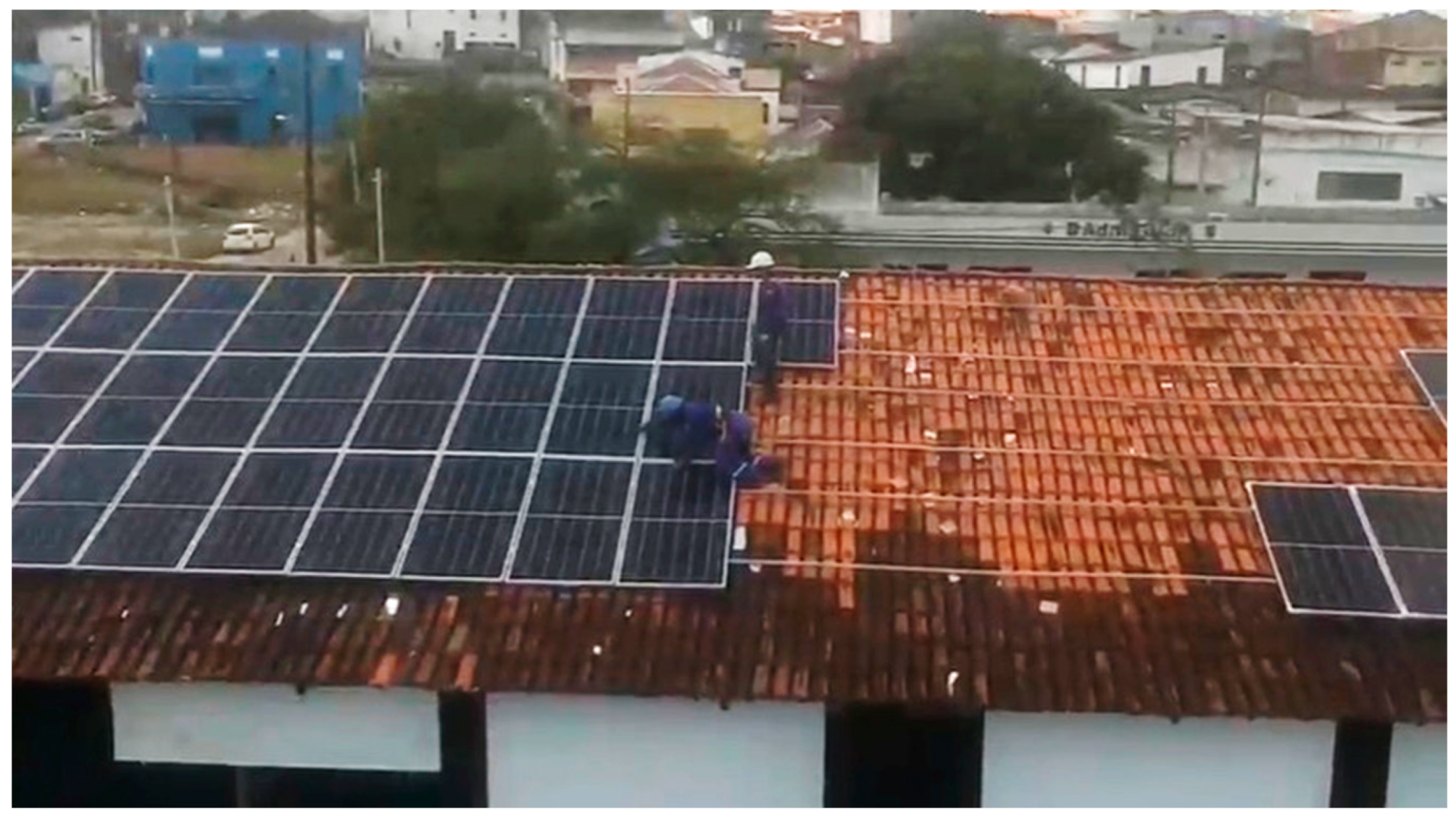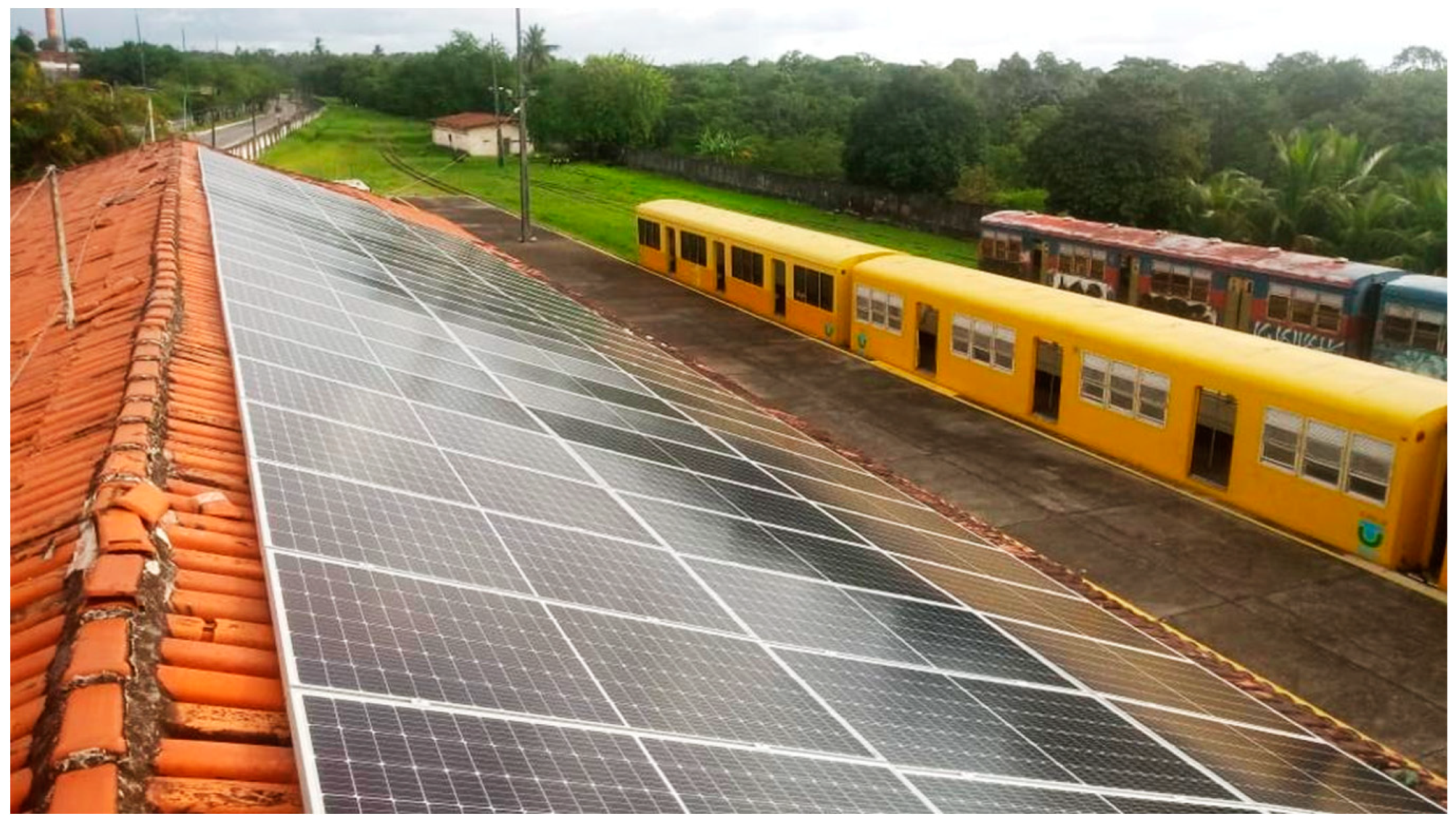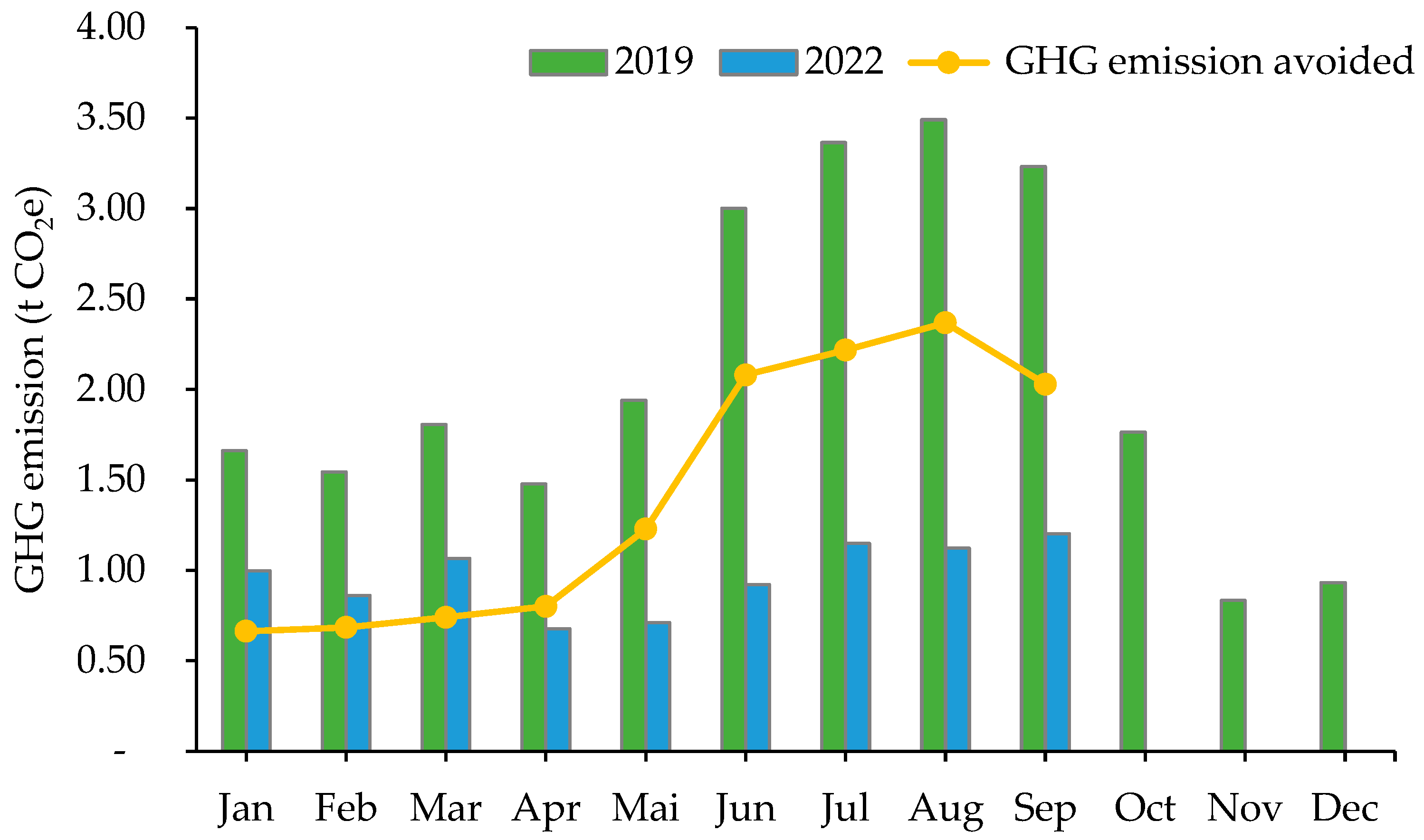An Approach for Water and Energy Savings in Public Buildings: A Case Study of Brazilian Rail Company
Abstract
:1. Introduction
2. Materials and Methods
2.1. SWEC Validation—Case Study
2.2. Sustainable Water and Energy Consumption Program Overview
2.3. Sustainable Water and Energy Consumption (SWEC) Program Framework
2.3.1. Users’ Conscientization and Consumption Diagnosis
2.3.2. Indicators for Evaluating Water and Energy Consumption
2.3.3. Clean Alternative Energy and Alternative Water Supplies
3. Results and Discussion
3.1. First 24-Months Results
3.2. Recent Results
3.3. Emission of Greenhouse Gas (GHG)
4. Limitations and Future Work
5. Conclusions
Author Contributions
Funding
Institutional Review Board Statement
Informed Consent Statement
Data Availability Statement
Acknowledgments
Conflicts of Interest
References
- Gassner, A.; Lederer, J.; Kanitschar, G.; Ossberger, M.; Fellner, J. Extended ecological footprint for different modes of urban public transport: The case of Vienna, Austria. Land Use Policy 2018, 72, 85–99. [Google Scholar] [CrossRef]
- Zisopoulou, K.; Zisopoulos, D.; Panagoulia, D. Water Economics: An In-Depth Analysis of the Connection of Blue Water with Some Primary Level Aspects of Economic Theory I. Water 2022, 14, 103. [Google Scholar] [CrossRef]
- Zisopoulou, K.; Panagoulia, D. An In-Depth Analysis of Physical Blue and Green Water Scarcity in Agriculture in Terms of Causes and Events and Perceived Amenability to Economic Interpretation. Water 2021, 13, 1693. [Google Scholar] [CrossRef]
- He, C.; Liu, Z.; Wu, J.; Pan, X.; Fang, Z.; Li, J.; Bryan, B.A. Future global urban water scarcity and potential solutions. Nat. Commun. 2021, 12, 4667. [Google Scholar] [CrossRef]
- Ji, L.; Yu, Z.; Ma, J.; Jia, L.; Ning, F. The Potential of Photovoltaics to Power the Railway System in China. Energies 2020, 13, 3844. [Google Scholar] [CrossRef]
- Barone, G.; Buonomano, A.; Forzano, C.; Giuzio, G.F.; Palombo, A. Assessing energy demands of building stock in railway infrastructures: A novel approach based on bottom-up modelling and dynamic simulation. Energy Rep. 2022, 8, 7508–7522. [Google Scholar] [CrossRef]
- Sanders, K.T. Critical Review: Uncharted Waters? The Future of the Electricity-Water Nexus. Environ. Sci. Technol. 2015, 49, 51–66. [Google Scholar] [CrossRef]
- Gellings, C.W. Evolving practice of demand-side management. J. Mod. Power Syst. Clean Energy 2017, 5, 1–9. [Google Scholar] [CrossRef] [Green Version]
- Boshell, F.; Veloza, O.P. Review of developed demand side management programs including different concepts and their results. In Proceedings of the 2008 IEEE/PES Transmission and Distribution Conference and Exposition: Latin America, Bogota, Colombia, 13–15 August 2008. [Google Scholar] [CrossRef]
- Moreno-Camacho, C.A.; Montoya-Torres, J.R.; Jaegler, A.; Gondran, N. Sustainability metrics for real case applications of the supply chain network design problem: A systematic literature review. J. Clean. Prod. 2019, 231, 600–618. [Google Scholar] [CrossRef]
- Nižetić, S.; Jurčević, M.; Čoko, D.; Arıcı, M. A novel and effective passive cooling strategy for photovoltaic panel. Renew. Sustain. Energy Rev. 2021, 145, 111164. [Google Scholar] [CrossRef]
- Ben Amara, H.; Bouadila, S.; Fatnassi, H.; Arici, M.; Guizani, A.A. Climate assessment of greenhouse equipped with south-oriented PV roofs: An experimental and computational fluid dynamics study. Sustain. Energy Technol. Assess. 2021, 45, 101100. [Google Scholar] [CrossRef]
- Shalaby, S.; Kabeel, A.E.; Moharram, B.E.; Shama, A.; Abosheiasha, H.A. Experimental study on the single basin solar still integrated with shell and spiral finned tube latent heat storage system enhanced by copper oxide nanoparticles. Environ. Sci. Pollut. Res. 2022. [Google Scholar] [CrossRef]
- Rasheed, M.B.; Javaid, N.; Ahmad, A.; Jamil, M.; Khan, Z.A.; Qasim, U.; Alrajeh, N. Energy Optimization in Smart Homes Using Customer Preference and Dynamic Pricing. Energies 2016, 9, 593. [Google Scholar] [CrossRef] [Green Version]
- Balouch, S.; Abrar, M.; Muqeet, H.A.; Shahzad, M.; Jamil, H.; Hamdi, M.; Malik, A.S.; Hamam, H. Optimal Scheduling of Demand Side Load Management of Smart Grid Considering Energy Efficiency. Front. Energy Res. 2022, 10, 861571. [Google Scholar] [CrossRef]
- Inman, D.; Jeffrey, P. A review of residential water conservation tool performance and influences on implementation effectiveness. Urban Water J. 2006, 3, 127–143. [Google Scholar] [CrossRef] [Green Version]
- Flores, R.A.; Ghisi, E. Benchmarking Water Efficiency in Public School Buildings. Sustainability 2022, 14, 3794. [Google Scholar] [CrossRef]
- Antunes, L.N.; Ghisi, E. Water and energy consumption in schools: Case studies in Brazil. Environ. Dev. Sustain. 2020, 22, 4225–4249. [Google Scholar] [CrossRef]
- Meron, N.; Meir, I.A. Building green schools in Israel. Costs, economic benefits and teacher satisfaction. Energy Build. 2017, 154, 12–18. [Google Scholar] [CrossRef]
- Katsaprakakis, D.A.; Zidianakis, G. Upgrading Energy Efficiency For School BuildingsIn Greece. Procedia Environ. Sci. 2017, 38, 248–255. [Google Scholar] [CrossRef]
- Khoshbakht, M.; Gou, Z.; Dupre, K. Energy use characteristics and benchmarking for higher education buildings. Energy Build. 2018, 164, 61–76. [Google Scholar] [CrossRef] [Green Version]
- Fonseca, P.; Moura, P.; Jorge, H.; De Almeida, A. Sustainability in university campus: Options for achieving nearly zero energy goals. Int. J. Sustain. High. Educ. 2018, 19, 790–816. [Google Scholar] [CrossRef]
- Tirado, D.; Nilsson, W.; Deyà-Tortella, B.; García, C. Implementation of Water-Saving Measures in Hotels in Mallorca. Sustainability 2019, 11, 6880. [Google Scholar] [CrossRef] [Green Version]
- Lee, M.; Tansel, B.; Balbin, M. Influence of residential water use efficiency measures on household water demand: A four year longitudinal study. Resour. Conserv. Recycl. 2011, 56, 1–6. [Google Scholar] [CrossRef]
- Lopes, A.D.C.P.; Filho, D.O.; Altoe, L.; Carlo, J.C.; Lima, B.B. Energy efficiency labeling program for buildings in Brazil compared to the United States’ and Portugal’s. Renew. Sustain. Energy Rev. 2016, 66, 207–219. [Google Scholar] [CrossRef]
- Polli, G.H.B. A Comparison about European Environmental Sustainability Rating Systems: BREEAM UK, DGNB, LiderA, ITACA and HQE. U. Porto J. Eng. 2020, 6, 46–58. [Google Scholar] [CrossRef]
- Ministério do Planejamento, Orçamento e Gestão (MPOG). Instrução Normativa n. 01 de 19 de Janeiro de 2010; Ministry of Planning, Budget and Management: Brasilia, Brazil, 2010. [Google Scholar]
- Casa Civil da Presidência da República. Decreto n. 7.746 de 05 de Junho de 2012; Civil House of the Presidency of the Republic: Brasilia, Brazil, 2012. [Google Scholar]
- Li, H.; Zhao, Y.; Lin, J. A review of the energy–carbon–water nexus: Concepts, research focuses, mechanisms, and methodologies. WIREs Energy Environ. 2020, 9, e358. [Google Scholar] [CrossRef]
- Commision of the European Union. Directive 2012/27/EU of the European Parliament and of the Council of 25 October 2012 on Energy Efficiency. Off. J. Eur. Union 2012, OJ L 315, 1–56. [Google Scholar]
- Da Fonseca-Soares, D.; Galvinicio, J.D.; Eliziário, S.A.; Ramos-Ridao, A.F. A Bibliometric Analysis of the Trends and Characteristics of Railway Research. Sustainability 2022, 14, 13956. [Google Scholar] [CrossRef]
- de Almeida Carneiro, M.; da Fonseca Soares, D. Solar Photovoltaic Assistance System Study for a Brazilian Light Rail Vehicle. U. Porto J. Eng. 2020, 6, 35–45. [Google Scholar] [CrossRef]
- Lee, M.; Tansel, B. Water conservation quantities vs customer opinion and satisfaction with water efficient appliances in Miami, Florida. J. Environ. Manag. 2013, 128, 683–689. [Google Scholar] [CrossRef]
- Tortajada, C.; González-Gómez, F.; Biswas, A.K.; Buurman, J. Water demand management strategies for water-scarce cities: The case of Spain. Sustain. Cities Soc. 2019, 45, 649–656. [Google Scholar] [CrossRef]
- Martínez-Espiñeira, R.; García-Valiñas, M.Á. Adopting versus adapting: Adoption of water-saving technology versus water conservation habits in Spain. Int. J. Water Resour. Dev. 2013, 29, 400–414. [Google Scholar] [CrossRef]
- Ehret, P.J.; Hodges, H.E.; Kuehl, C.; Brick, C.; Mueller, S.; Anderson, S.E. Systematic Review of Household Water Conservation Interventions Using the Information–Motivation–Behavioral Skills Model. Environ. Behav. 2020, 53, 485–519. [Google Scholar] [CrossRef]
- Englart, S.; Jedlikowski, A. The influence of different water efficiency ratings of taps and mixers on energy and water consumption in buildings. SN Appl. Sci. 2019, 1, 525. [Google Scholar] [CrossRef] [Green Version]
- Barberán, R.; Egea, P.; Gracia-De-Rentería, P.; Salvador, M. Evaluation of water saving measures in hotels: A Spanish case study. Int. J. Hosp. Manag. 2013, 34, 181–191. [Google Scholar] [CrossRef]
- Melquíades, T.F.; Diniz, F.F.; Nunes, A.M.M.; Martins, J.M.; Júnior, E.P.S.; Junior, L.M.C. Previsão da radiação solar global em João Pessoa, Paraíba, Brasil: Uma aplicação dos modelos da família ARIMA. Concilium 2022, 22, 213–224. [Google Scholar] [CrossRef]
- Pereira, S.D.; Cabral, J.P.C. Informalidade e crise do emprego no Brasil (Informality and the employment crisis in Brazil). Humanid. Inovação 2019, 6, 92–102. [Google Scholar]
- Roccaro, P.; Falciglia, P.P.; Vagliasindi, F.G.A. Effectiveness of water saving devices and educational programs in urban buildings. Water Sci. Technol. 2011, 63, 1357–1365. [Google Scholar] [CrossRef]
- Ketter, E.; Avraham, E. The social revolution of place marketing: The growing power of users in social media campaigns. Place Brand. Public Dipl. 2012, 8, 285–294. [Google Scholar] [CrossRef]
- Takagi, K.; Otaki, M.; Otaki, Y.; Chaminda, T. Availability and public acceptability of residential rainwater use in Sri Lanka. J. Clean. Prod. 2019, 234, 467–476. [Google Scholar] [CrossRef]
- De Andrade, A.E.F.; Anthayde, G.B., Jr.; Carneiro, M.D.A.; Ferraz, E.K.V. Estudo da viabilidade econômica para sistema de aproveitamento de águas de chuva na sede da companhia brasileira de trens urbanos em João Pessoa/PB (Economical viability study of a rainwater harvesting system to the João Pessoa company of urban trains). In Proceedings of the 2nd National Symposium on Urban Management and Engineering (SINGEURB 2019), São Paulo, Brazil, 27–29 November 2019; Blucher: São Paulo, Brazil; pp. 560–568. [Google Scholar] [CrossRef]
- Santana, T.C.; Guiselini, C.; Cavalcanti, S.D.L.; da Silva, M.V.; Vigoderis, R.B.; Júnior, J.A.S.; Moraes, A.S.; Jardim, A.M.D.R.F. Quality of rainwater drained by a green roof in the metropolitan region of Recife, Brazil. J. Water Process Eng. 2022, 49, 102953. [Google Scholar] [CrossRef]
- Intergovernmental Panel on Climate Change (IPCC). Climate Change 2021: The Physical Science Basis; Cambridge University Press: Cambridge, UK; New York, NY, USA, 2021; 2391p. [Google Scholar]
- Goldemberg, J.; Lucon, O. Energia, Meio Ambiente & Desenvolvimento, 2nd ed.; Editora da Universidade de São Paulo: São Paulo, Brazil, 2003. [Google Scholar]
- Ministério da Ciência, Tecnologia, Inovação e Comunicação. Fatores de Emissão de CO2 para Utilizações que Necessitam do Fator Médio de Emissão do Sistema Interligado Nacional do Brasil; Ministry of Science, Technology, Innovation and Communication: Brasilia, Brazil, 2021. [Google Scholar]
- World Resources Institute and World Business Council for Sustainable Development. Product Lifecycle Reporting and Accounting Standard; WRI & WRBSD: Washington, DC, USA, 2011. [Google Scholar]
- ISO 14040 (E); Environmental Management: Life Cycle Assesment—Principles and Frameworks. ISO: Geneva, Switzerland, 2006.
- ISO 14044 (E); Environmental Management: Life Cycle Assesment—Requirements and Guidelines. ISO: Geneva, Switzerland, 2006.
- Ali, M.; Munala, G.; Muhoro, T.; Shikuku, J.; Nyakundi, V.; Gremley, A. Water Usage Patterns and Water Saving Devices in Households: A Case of Eastleigh, Nairobi. J. Water Resour. Prot. 2020, 12, 303. [Google Scholar] [CrossRef] [Green Version]
- Ferraz, E.K.V.; de Almeida Carneiro, M.; Anthayde, G.B., Jr.; De Andrade, A.E.F. Análise de um programa de consumo sustentável na redução do consumo de água e energia na empresa de trens urbanos de João Pessoa (Analysis of a sustainable consumption program in the reduction of water and energy consumption in the company of urban trains of João Pessoa). In Proceedings of the 2nd National Symposium on Urban Management and Engineering (SINGEURB 2019), São Paulo, Brazil, 27–29 November 2019; pp. 586–593. [Google Scholar] [CrossRef]
- Dean, A.J.; Kneebone, S.; Tull, F.; Lauren, N.; Smith, L.D. ‘Stickiness’ of water-saving behaviours: What factors influence whether behaviours are maintained or given up? Resour. Conserv. Recycl. 2021, 169, 105531. [Google Scholar] [CrossRef]





| Water | Energy |
|---|---|
| Reduce water loss and waste | Reduce energy consumption and consequently expenses with electricity |
| Reduce consumption, and consequently, expenses on drinking water supply | Replace inefficient equipment |
| Keep a reduced consumption profile over time | |
| Implement a structured water use management system | |
| Make users aware of the sustainable use of water to reduce waste from misuse | |
| Apply new tools and technologies for intelligent and efficient use of water | |
| Category | Source |
|---|---|
| Consumption | 24 months water and energy bills, hydrometer, and electricity meter |
| Expenses | 24 months of water and energy bills |
| Consuming components | Inventory of goods and on-site inspections |
| Indicator | Description |
|---|---|
| W1—Global consumption of water (m3) | Volume of piped water consumed by all buildings |
| W2—Local consumption (m3) | Volume of piped water consumed by each building |
| W3—Self-closing faucet (%) | Number of self-closing faucets divided by the total number of faucets |
| W4—Leaking hydraulic components (%) | Number of leaking items divided by the total number of hydraulic items |
| W5—Per capita water consumption (m3/employee) | Water consumed per employee |
| E1—Global consumption of electricity (kWh) | Electricity consumed by all buildings |
| E2—Local consumption of electricity (kWh) | Electricity consumed by each building |
| E3—LED lighting (%) | Number of LED lightning divided by the total number of lightning |
| E4—Per capita electricity consumption (kWh/employee) | Electricity consumed divided by the number of employees |
| S—Strengths | W—Weakness |
| High potential of cost reduction with water and energy | Manpower shortage for the company´s buildings maintenance |
| Demands are concentrated in a few key buildings of the company, facilitating the monitoring of the Program | Absence of scheduled maintenance of the hydraulic and electrical networks |
| Alignment of the program with the company´s strategic planning | Risk of low adherence to the Program by the staff |
| Increase the quality of life at work through the application of modern devices and technologies | |
| O—Opportunities | T—Threats |
| Change of conventional tariff modality in the Workshop facility for the horo-seasonal model | Tariff adjustment of water and energy concessionaires |
| The public impression of rational water and energy use | Energy and water deviation |
| Brazilian government cost-cutting measures | Vandalism in water and energy consuming items (e.g., lightings, faucets, flushing, etc.) |
| Environmental legislative changes and sustainable bidding demand for the Public Administration |
| Indicator | Main Results |
|---|---|
| W1—Global consumption of water (m3) | Increased 37%, from 562.5 to 771.5 m3. |
| W2—Local consumption (m3) | - |
| W3—Self-closing faucet (%) | Did not suffer any variation. |
| W4—Leaking hydraulic components (%) | Increased from 7% to 9%. |
| W5—Per capita water consumption (m3 /employee) | Reduced 10%. |
| E1—Global consumption of electricity (kWh) | Reduced 11.2%. |
| E2—Local consumption of electricity (kWh) | - |
| E3—LED lighting (%) | Increased from 20% to 27%. |
| E4—Per capita electricity consumption (kWh/employee) | Reduced 19%, from 184 kWh to 150 kWh. |
| Consumption (kWh) | Year | January | February | March | April | May | June | July | August | September | October | November | December |
| 2019 | 25,951 | 25,395 | 28,426 | 28,251 | 31,944 | 32,797 | 31,273 | 29,556 | 27,342 | 21,993 | 22,775 | 27,175 | |
| 2022 | 15,592 | 14,153 | 16,779 | 12,949 | 11,715 | 10,065 | 10,670 | 9506 | 10,178 | - | - | - | |
| Reduction | −40% | −44% | −41% | −54% | −63% | −69% | −66% | −68% | −63% |
| Year | January | February | March | April | May | June | July | August | September | October | November | December |
|---|---|---|---|---|---|---|---|---|---|---|---|---|
| 2019 | 1.66 | 1.54 | 1.81 | 1.48 | 1.94 | 3.00 | 3.36 | 3.49 | 3.23 | 1.76 | 0.83 | 0.93 |
| 2022 | 1.00 | 0.86 | 1.07 | 0.68 | 0.71 | 0.92 | 1.15 | 1.12 | 1.20 | - | - | - |
| GHG emission avoided | 0.66 | 0.68 | 0.74 | 0.80 | 1.23 | 2.08 | 2.22 | 2.37 | 2.03 | - | - | - |
Publisher’s Note: MDPI stays neutral with regard to jurisdictional claims in published maps and institutional affiliations. |
© 2022 by the authors. Licensee MDPI, Basel, Switzerland. This article is an open access article distributed under the terms and conditions of the Creative Commons Attribution (CC BY) license (https://creativecommons.org/licenses/by/4.0/).
Share and Cite
Carneiro, M.A.; Da Fonseca-Soares, D.; Pereira, L.H.M.; Ramos-Ridao, A.F. An Approach for Water and Energy Savings in Public Buildings: A Case Study of Brazilian Rail Company. Sustainability 2022, 14, 15921. https://doi.org/10.3390/su142315921
Carneiro MA, Da Fonseca-Soares D, Pereira LHM, Ramos-Ridao AF. An Approach for Water and Energy Savings in Public Buildings: A Case Study of Brazilian Rail Company. Sustainability. 2022; 14(23):15921. https://doi.org/10.3390/su142315921
Chicago/Turabian StyleCarneiro, Mariko Almeida, Diogo Da Fonseca-Soares, Lucian Hendyo Max Pereira, and Angel Firmín Ramos-Ridao. 2022. "An Approach for Water and Energy Savings in Public Buildings: A Case Study of Brazilian Rail Company" Sustainability 14, no. 23: 15921. https://doi.org/10.3390/su142315921





